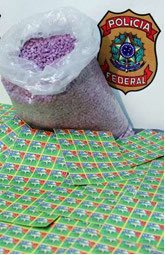The substance that defines the ecstasy it's the 3,4-methylenedioxymethamphetamine, better known by the acronym MDMA. Its structural formula is shown below, being a compound amphetamine derivative, that is, synthetic substances belonging to the amine group that act on the nervous system, stimulating it.

However, ecstasy is not part of the amphetamine group. To better understand this group and verify its distinction with ecstasy, read the text “Amphetamine Chemistry”.
MDMA has part of its molecule similar to a hallucinogen, however, it does not produce lysergic acid (LSD) hallucinations, nor the stimulant effects of cocaine. Its effects are like a mild mixture of the two substances.

Its use is illegal and causes numerous adverse reactions, which can even lead to death. The biggest cause of death associated with the use of ecstasy is hyperthermia, that is, an increase in body temperature, which causes overheating.
This is because ecstasy acts on the brain's neurotransmitters (serotonin, dopamine and norepinephrine). The one that is most influenced by this drug is serotonin, responsible for controlling emotions, regulating the sensory and motor domains, the associative capacity of the brain and also regulate the temperature of the body. With ecstasy achieving this serotonin function, the body can reach temperatures above 41°C, causing the blood to clot, producing seizures and cardiac arrest.
Other side effects of using this drug are: headaches, muscle pain, nausea, toxic hepatitis, kidney problems, cardiac arrhythmia, hallucinations and panic attacks.
By Jennifer Fogaça
Graduated in Chemistry
Source: Brazil School - https://brasilescola.uol.com.br/quimica/quimica-ecstasy.htm
